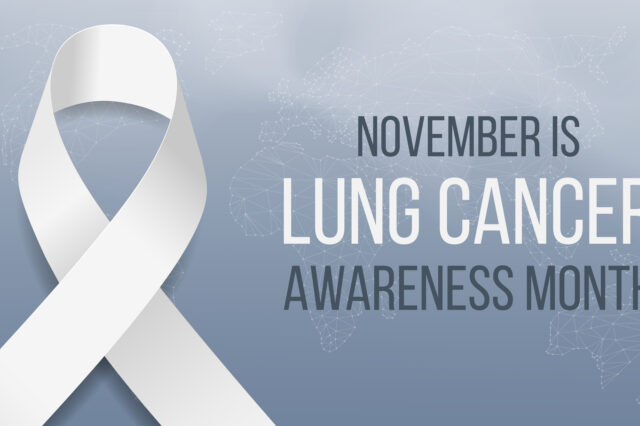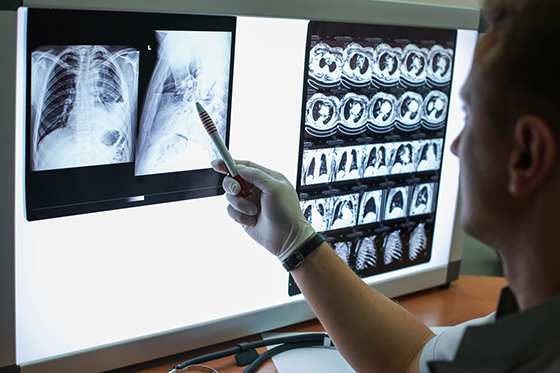Lung Cancer Awareness Month: Early Detection Makes the Difference


Lung cancer has a way of staying hidden and becoming increasingly fatal the longer it does so. There are enormous benefits to shining light on this particular cancer early on, and that’s more possible now than it used to be.
Early detection, which is crucial in all cases of cancer, gives patients options they otherwise wouldn’t have since the disease may be smaller in size and hasn’t metastasized to other regions of the body. However, identifying lung cancer in its beginning stages can have an even more distinguishable impact on survival when compared to other types.
Since lung cancer stands out due to its prevalence (second-most common type), mortality (deadliest type) and tendency to fly under the radar, early detection is vital with this disease. With November being Lung Cancer Awareness Month, now is a great time to bring attention to this.
Lung cancer stays out of sight
One of the reasons why lung cancer is the deadliest type of cancer for both men and women in the United States is the fact that symptoms don’t emerge until the disease has reached an advanced, non-curable stage.
Only then does the patient begin to experience a cough that is persistent, progressive or even bloody. Other symptoms come in the form of chest pain, difficulty breathing or infections such as bronchitis or pneumonia. Even when these things show up, they’re commonly confused with the side effects of smoking or another sickness.
The lack of warning signs makes it important for patients to be proactive in getting yearly screenings. Those at high risk — individuals who smoke, inhale secondhand smoke, get exposed to high radon levels or other substances, or those with a family history of lung cancer — should get their lungs checked on a regular basis.
Early screening and its impact on survival
Time is a critical factor when it comes to those with lung cancer. For those diagnosed during 2010 through 2016, and considering all stages combined, lung cancer has a 5-year relative survival rate of 21%, according to info published this year by the American Cancer Society. That percentage is lower than any form of cancer listed in the report, with the exceptions being pancreatic cancer (10%), liver cancer (20%) and esophageal cancer (20%).
These statistics can vary a great deal depending on the type and stage of the lung cancer. With that said, screening that leads to early detection while it’s still localized within the lungs can dramatically increase the five-year survival rate.
In some cases, catching the disease in its earliest stages can have a striking effect. For example, early detection through screening can increase the 5-year survival rate for a detected stage I lung cancer to nearly 90%.
At the UF Health Lung Cancer Program, 9 out of 10 lung cancer referrals are seen within seven days. That accessibility is key to giving our patients the best possible chance in the battle.

A better method for detection is here
When it comes to those checkups, there hasn’t been a widely accepted screening tool available for early-stage lung cancer until recently. Far too often, regular chest X-rays have missed lung tumors during the most beneficial time to be a reliable method for detection.
Supported by the National Lung Screening Trial (NLST) and the American Society of Clinical Oncologists, along with many studies, low-dose computed tomography (LDCT) has proven to be more effective at detection than chest X-rays for those at high risk. Unlike the single-picture chest X-ray, the multi-picture CT scan uses detailed cross-sectional images of the body. The CT scanner does this by rotating around you while you lie on a table and taking several X-rays.
The LDCT scan’s superior ability to uncover lung tumors, even small lesions that could potentially carry cancer, is a key reason the NLST and other research has shown that getting annual LDCT scans before symptoms appear can help reduce the risk of dying from lung cancer.
UF Health offers LDCT scans, which are now covered by Medicare once per year for beneficiaries who meet these criteria:
- ages 55-77, and are either current smokers or have quit smoking within the last 15 years
- tobacco smoking history of at least 30 “pack years” (an average of one pack a day for 30 years)
- receive a written order from a physician or qualified non-physician practitioner who meets certain requirements
Please ask your primary physician for more info and to schedule an appointment if necessary.
About the author
